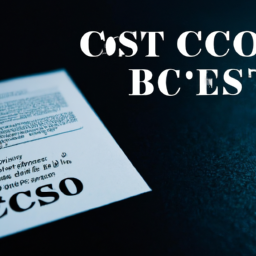How Do We Determine The Cost-effectiveness Of Our Business Continuity Measures?
Running a successful business requires not only efficient operations but also the ability to anticipate and mitigate potential risks. This is where business continuity measures come into play, ensuring that your company can withstand unexpected disruptions. However, a crucial question arises: how do you determine the cost-effectiveness of these measures? Evaluating the financial impact can be a complex task, involving not only the initial investment but also ongoing maintenance and potential savings. In this article, we will explore various factors to consider when assessing the cost-effectiveness of your business continuity measures, helping you make informed decisions that protect your bottom line without compromising on security.
1. Understand the Importance of Cost-Effectiveness
1.1 Importance of Evaluating Business Continuity Measures
When it comes to ensuring the resilience and stability of your organization, evaluating the effectiveness of your business continuity measures is crucial. By conducting a thorough assessment, you can identify any gaps or weaknesses in your existing strategies, allowing you to make necessary improvements and enhancements. Evaluating your business continuity measures also helps you allocate resources efficiently and effectively, ensuring that you invest in measures that provide the most value to your organization.
1.2 The Role of Cost-Effectiveness in Decision-Making
Cost-effectiveness plays a significant role in decision-making for business continuity measures. It involves evaluating the costs associated with implementing and maintaining these measures compared to the benefits they provide. By assessing the cost-effectiveness of each measure, you can make informed decisions about which ones to invest in, ensuring that you achieve the desired level of resilience without incurring unnecessary expenses. This analysis allows you to optimize your resources and ensure the long-term sustainability of your organization.
1.3 Benefits of Cost-Effective Business Continuity Measures
Implementing cost-effective business continuity measures offers several benefits to your organization. Firstly, it ensures that you can maintain your business operations in the face of disruptions, minimizing downtime and reducing financial losses. Cost-effective measures also allow you to allocate resources to other critical areas of your organization, enhancing overall performance and productivity. Additionally, by assessing the cost-effectiveness of your measures, you can build trust and confidence among stakeholders, demonstrating that you are responsible and proactive in mitigating risks.
2. Define Key Performance Indicators (KPIs)
2.1 Identification of Relevant KPIs
Defining key performance indicators (KPIs) is essential in evaluating the cost-effectiveness of your business continuity measures. KPIs serve as measurable metrics that allow you to assess the success and effectiveness of your measures. When selecting KPIs, it is important to identify those that are relevant to your specific business objectives and align with the desired outcomes of your continuity plan. These KPIs could include metrics such as downtime reduction, financial savings, customer satisfaction, and employee productivity.
2.2 Aligning KPIs with Business Objectives
To ensure the meaningful evaluation of your business continuity measures, it is crucial to align your selected KPIs with your organization’s overall business objectives. By doing so, you can measure the impact of your measures on the achievement of these objectives. For example, if your business objective is to maintain a high level of customer satisfaction, you can establish KPIs that monitor the impact of your continuity measures on customer service levels, response times, and overall customer experience.
2.3 Establishing Baseline Metrics for Comparison
To effectively evaluate the cost-effectiveness of your business continuity measures, it is important to establish baseline metrics for comparison. Baseline metrics serve as a reference point against which you can measure the impact and improvements brought about by your measures. These metrics could include pre-implementation data on financial losses, downtime duration, and customer complaints. By comparing the performance before and after the implementation of your measures, you can determine whether your investments have been cost-effective in mitigating risks and enhancing business resilience.
3. Conduct a Risk Assessment
3.1 Identify Potential Risks and Disruptions
A thorough risk assessment is a fundamental step in determining the cost-effectiveness of your business continuity measures. This assessment involves identifying and understanding the potential risks and disruptions that your organization may face. It is important to consider both internal and external factors that could impact your business operations, such as natural disasters, cyber threats, supply chain disruptions, and human errors. By gaining a comprehensive understanding of the risks, you can prioritize your investment in cost-effective measures that address the most significant threats.
3.2 Assess Probability and Impact of Risks
Once the potential risks have been identified, it is essential to assess their probability and potential impact on your organization. This analysis involves evaluating the likelihood of each risk occurring and the severity of its consequences. By assigning probabilities and impact ratings to each risk, you can prioritize your efforts and resources towards the risks that pose the greatest threat. This assessment also helps in determining the cost-effectiveness of your measures as it allows you to focus on mitigating the risks that have the highest likelihood and impact.
3.3 Prioritize Risks Based on Severity
After assessing the probability and impact of each risk, it is crucial to prioritize them based on severity. This prioritization enables you to allocate your resources and investment in a way that ensures the most critical risks are adequately addressed. By focusing on the most severe risks, you can minimize potential financial losses, operational disruptions, and reputational damage. Prioritizing risks also helps in determining the cost-effectiveness of your measures, as it allows you to invest proportionately based on the severity and potential consequences of each risk.
4. Determine Cost of Business Disruptions
4.1 Calculation of Financial Losses
Determining the cost of business disruptions is a key factor in assessing the cost-effectiveness of your business continuity measures. This involves calculating the financial losses that your organization would incur in the event of a disruption. Consider the direct costs of downtime, such as lost sales, production delays, and increased labor costs. Additionally, factor in the indirect costs, such as reputational damage, customer churn, and potential legal liabilities. By quantifying the financial impact of disruptions, you can evaluate the cost-effectiveness of your measures in terms of their ability to mitigate these losses.
4.2 Consideration of Operational Costs
When evaluating the cost-effectiveness of your business continuity measures, it is important to consider the operational costs associated with their implementation and maintenance. These costs include investments in technology, infrastructure, training, and ongoing testing and maintenance. By understanding the operational costs, you can analyze the return on investment (ROI) of your measures and determine whether they provide long-term cost savings compared to the potential financial losses incurred during a disruption. Striking a balance between operational costs and potential savings is vital in ensuring cost-effectiveness.
4.3 Quantifying Reputational Damage
While financial losses are often the focus when evaluating the cost of business disruptions, it is crucial to also consider the potential reputational damage that can occur. Reputational damage can have long-lasting effects on customer trust, brand reputation, and overall business performance. By quantifying the potential impact on your reputation, you can incorporate these costs into your cost-effectiveness analysis. Investing in measures that minimize reputational damage can be highly cost-effective in the long run, as it helps maintain customer loyalty, attract new customers, and preserve the overall value of your brand.
5. Evaluate Existing Business Continuity Measures
5.1 Review Current Strategies and Procedures
To determine the cost-effectiveness of your business continuity measures, it is essential to conduct a thorough review of your current strategies and procedures. This involves evaluating the effectiveness of your existing measures in mitigating risks and ensuring business resilience. Identify any gaps or weaknesses in your current approach and assess whether the resources allocated to each measure are proportional to the potential risks they address. This evaluation provides insights into the areas where improvements or adjustments are necessary to enhance cost-effectiveness.
5.2 Assess Effectiveness in Mitigating Risks
As part of the evaluation process, it is crucial to assess the effectiveness of your existing business continuity measures in mitigating risks. This assessment involves analyzing the actual outcomes and impact of your measures in minimizing the probability and consequences of disruptions. Consider the data and feedback collected during previous incidents or tests, and evaluate whether the expected results were achieved. By determining the effectiveness of your measures, you can identify areas that require improvement or alternative approaches that offer greater cost-effectiveness.
5.3 Identify Gaps and Areas for Improvement
Based on the evaluation of your existing measures, you will likely identify gaps or areas for improvement. These gaps may include insufficient coverage of certain risks, outdated procedures, or inadequate resource allocation. It is important to prioritize these gaps based on their potential impact and the cost-effectiveness of addressing them. By addressing these gaps, you can enhance the overall effectiveness and cost-efficiency of your business continuity measures. Regularly reviewing and improving your measures ensures that you stay ahead of emerging risks and maintain a high level of resilience.
6. Identify Potential Cost-Effective Measures
6.1 Brainstorming and Idea Generation
To identify potential cost-effective measures, it is important to engage in brainstorming and idea generation sessions. This involves gathering input from key stakeholders, such as department heads, employees, and risk management professionals. Encourage creative thinking and consider a wide range of solutions and approaches. During this process, focus on identifying measures that address the most significant risks identified during the risk assessment phase. Brainstorming sessions provide valuable insights and diverse perspectives, helping to identify innovative and cost-effective approaches to enhance business continuity.
6.2 Assessing Feasibility and Resource Requirements
Once potential measures have been identified, it is important to assess their feasibility and resource requirements. Consider factors such as the availability of resources, the technical feasibility of implementation, and the skills and expertise required. Evaluate whether the proposed measures can be implemented within the established budget and timeline. Additionally, consider how the proposed measures align with your organization’s overall strategy and objectives. By assessing feasibility and resource requirements, you can ensure that only the most viable and cost-effective measures are pursued.
6.3 Prioritizing Measures Based on Cost and Benefits
When evaluating potential cost-effective measures, it is necessary to prioritize them based on their cost and benefits. Consider the upfront and ongoing costs associated with each measure, as well as the potential benefits in terms of risk mitigation, operational efficiency, and financial savings. Allocate resources in a way that addresses the most critical risks while maximizing cost-effectiveness. Prioritizing measures ensures that you invest in those that provide the greatest value and impact, helping to achieve the desired level of resilience while optimizing resource allocation.
7. Consider External Factors and Compliance
7.1 Legal and Regulatory Requirements
When assessing the cost-effectiveness of your business continuity measures, it is important to consider legal and regulatory requirements. Depending on your industry and location, there may be specific regulations or standards that govern business resilience and continuity planning. Ensure that your measures align with these requirements to avoid potential penalties or legal consequences. Compliance with legal and regulatory obligations is not only essential from a risk management perspective but also contributes to the overall cost-effectiveness and sustainability of your organization.
7.2 Industry Standards and Best Practices
In addition to legal and regulatory requirements, it is crucial to consider industry standards and best practices when evaluating the cost-effectiveness of your business continuity measures. Industry standards provide guidelines and benchmarks for business resilience, ensuring that your organization meets or exceeds the expectations of customers, partners, and stakeholders. By aligning your measures with industry best practices, you can demonstrate that you are proactive in mitigating risks and adapting to changing environments. Adhering to industry standards contributes to the overall cost-effectiveness and competitiveness of your organization.
7.3 Insurance Policies and Coverage
Insurance plays a significant role in assessing the cost-effectiveness of your business continuity measures. Review your existing insurance policies and coverage to ensure that they align with your risk management objectives. Assess the adequacy of coverage for potential financial losses, including property damage, business interruption, and liability claims. By ensuring comprehensive coverage, you can mitigate the financial impact of disruptions and enhance cost-effectiveness. Regularly review and update your insurance policies to reflect changes in your business operations and evolving risks.
8. Conduct Cost-Benefit Analysis
8.1 Assigning Monetary Values to Costs and Benefits
Conducting a cost-benefit analysis is crucial in evaluating the cost-effectiveness of your business continuity measures. Start by assigning monetary values to the costs associated with each measure, including upfront investments, operational costs, and ongoing maintenance expenses. Next, assign monetary values to the potential benefits, such as financial savings, reduced downtime, and improved customer satisfaction. This analysis allows you to compare the costs and benefits of different measures on a standardized basis, providing insights into their relative cost-effectiveness.
8.2 Comparing Costs and Benefits of Different Measures
When conducting a cost-benefit analysis, it is important to compare the costs and benefits of different measures. Evaluate the potential return on investment (ROI) for each measure by assessing the ratio of benefits to costs. Consider the long-term impact of the measures, as well as any synergies or trade-offs between multiple measures. This analysis helps in selecting the most cost-effective measures that provide the greatest value and impact for your organization. By comparing the costs and benefits, you can make informed decisions and prioritize resource allocation.
8.3 Assessing Return on Investment (ROI)
Assessing the return on investment (ROI) is a critical aspect of determining the cost-effectiveness of your business continuity measures. The ROI calculation involves comparing the financial returns or benefits generated by the measures to the investment or costs incurred. By analyzing the ROI, you can determine whether the measures provide a positive return or if adjustments are necessary to enhance cost-effectiveness. A positive ROI indicates that the benefits outweigh the costs, demonstrating the value and efficiency of the measures in ensuring business resilience.
9. Implement and Monitor Cost-Effective Measures
9.1 Develop Implementation Plan and Timeline
Once you have determined the most cost-effective measures, it is essential to develop a detailed implementation plan and timeline. This plan outlines the specific steps, resources, and activities required to implement each measure successfully. Consider the dependencies and interdependencies between different measures to ensure smooth and coordinated implementation. Establish a realistic timeline that allows for proper testing, training, and adjustment of the measures. A well-structured implementation plan and timeline contribute to the overall cost-effectiveness of your measures by ensuring efficient and timely execution.
9.2 Allocate Resources and Assign Responsibilities
Allocate the necessary resources and assign responsibilities to individuals or teams responsible for implementing and maintaining the cost-effective measures. This includes providing the required budget, personnel, and technology. Clearly define roles and responsibilities to ensure accountability and effective coordination. Regularly communicate with your team to provide guidance and support throughout the implementation process. Effective resource allocation and role assignment contribute to the successful implementation and long-term cost-effectiveness of the measures.
9.3 Establish Monitoring and Evaluation Mechanisms
To ensure the ongoing cost-effectiveness of your measures, it is crucial to establish monitoring and evaluation mechanisms. Regularly assess the performance and impact of the implemented measures against the defined KPIs and baseline metrics. Monitor changes in risks, organizational priorities, and external factors that may impact the effectiveness and cost-effectiveness of the measures. Continuously evaluate and adjust your measures as needed to address emerging risks and changing business needs. The establishment of robust monitoring and evaluation mechanisms ensures that your measures remain effective and cost-efficient over time.
10. Periodic Review and Continuous Improvement
10.1 Regularly Assess the Effectiveness of Measures
Periodically assess the effectiveness of your cost-effective measures to ensure their ongoing viability and relevance. Conduct regular reviews and evaluations of the measures against the established KPIs and baseline metrics. Analyze performance data, feedback from employees and stakeholders, and incident reports to identify areas that require improvement. By regularly assessing the effectiveness of your measures, you can fine-tune them to enhance their cost-effectiveness and ensure that they continue to address the most significant risks.
10.2 Track Cost Savings and Benefits over Time
To evaluate the long-term cost-effectiveness of your measures, track cost savings and benefits over time. Compare the financial losses and operational disruptions experienced before and after the implementation of the measures. Quantify the financial and non-financial benefits that have been achieved, such as reduced downtime, improved customer satisfaction, and enhanced brand reputation. By tracking cost savings and benefits, you can demonstrate the long-term value and cost-effectiveness of your measures, providing valuable insights for future decision-making.
10.3 Adapt and Improve Strategies as Needed
As part of your commitment to continuous improvement, be open to adapting and improving your business continuity strategies as needed. Stay informed about emerging risks, technology advancements, and industry trends that may impact your organization. Regularly evaluate the cost-effectiveness of your measures and assess whether adjustments or alternative approaches are necessary to address evolving risks and achieve optimal efficiency. Embrace a culture of innovation and learning that allows for agility and responsiveness in enhancing the cost-effectiveness of your business continuity measures.
In conclusion, determining the cost-effectiveness of your business continuity measures requires a systematic and comprehensive approach. By understanding the importance of cost-effectiveness, defining appropriate KPIs, conducting a risk assessment, and considering the cost of business disruptions, you can develop a solid foundation for evaluating the effectiveness and efficiency of your measures. Through a thorough evaluation of existing measures, identification of potential cost-effective alternatives, and consideration of external factors, you can make informed decisions and implement measures that provide the greatest value and impact. Regular monitoring, periodic reviews, and continuous improvement ensure that your measures remain relevant and cost-effective over time, enhancing the resilience and sustainability of your organization.








